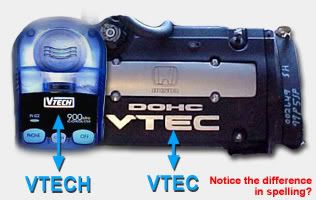VTEC
VTEC (standing for Variable valve Timing and lift Electronic Control) is a system developed by Honda Motor Co., Ltd. to improve the combustion efficiency of its internal combustion engines throughout the RPM range. This was the FIRST SYSTEM of its kind and eventually led to different types of variable valve timing and lift control systems that were later designed by other manufacturers (i.e. VVT-i from Toyota or VANOS from BMW).
Visual Aid/Video
More of a visual learner or just dont like to read?
VTEC operation explained by Honda
Introduction to VTEC
In the regular four-stroke automobile engine, lobes on a camshaft actuate the intake and exhaust valves. The shapes of the lobes’ determine both the timing and the lift of each valve. Timing refers to when a valve is opened or closed with respect to the combustion cycle. Lift refers to how much the valve is opened. Due to the behavior of the gases (air and fuel mixture) before and after combustion, which have physical limitations on their flow, as well as their interaction with the ignition spark, the optimal valve timing and lift settings under low RPM engine operations are very different from those under high RPM. Optimal low RPM valve timing and lift settings would result in insufficient fuel and air at high rpm, thus greatly limiting engine power output. Conversely, optimal high rpm valve timing and lift settings would result in very rough low RPM operation and difficult idling. The ideal engine would have fully variable valve timing and lift, in which the valves would always open at exactly the right point and lift high enough for the engine speed in use.
In practice, such a perfectly adjustable timing and lift system is complex and expensive to implement and is therefore found only in costly experimental and limited production engines. The vast majority of modern automobile engines operate with a fixed camshaft profile that represents a compromise between low RPM smoothness and high RPM power output. And since the average automobile engine spends most of its time running in the low RPM region, there is typically more emphasis on low RPM smoothness at the expense of high RPM output. Performance-tuned engines have cam profiles that are optimized more towards high RPM operation, where the greatest power can be obtained. But this means that low speed operation is compromised. Anyone who has heard a racing car or a highly-tuned hot rod sitting at idle will note that the engine sounds like it is barely capable of running at that speed.
DOHC VTEC
Honda's VTEC system is a simple and fairly elegant method of endowing the engine with multiple camshaft profiles optimized for low and high RPM operations. Instead of only one cam lobe actuating each valve, there are two - one optimized for low RPM smoothness and one to maximize high RPM power output. The engine’s management computer controls switching between the two cam lobes. As engine RPM increases, a locking pin is pushed by oil pressure to bind the high RPM cam follower for operation. From this point on, the valve opens and closes according to the high-speed profile, which opens the valve further and for a longer time. The VTEC system was originally introduced as a DOHC system in the 1989 Honda Integra sold in Japan, which used a 160 hp (119 kW) variant of the B16A engine. The US market saw the first VTEC system with the introduction of the 1990 Acura NSX, which used a DOHC V6. The DOHC VTEC system has high and low RPM cam lobe profiles on both the intake and exhaust valve camshafts. This resulted in the most power gain at high RPMs and DOHC VTEC engines were thus used in the highest performance Honda automobiles. In contrast to the SOHC implementation, which switches between cams profiles seamlessly, when the DOHC version switches cams there is a definite change in the engine note.
SOHC VTEC
As popularity and marketing value of the VTEC system grew, Honda applied the system to SOHC engines, which shares a common camshaft for both intake and exhaust valves. The trade-off is that SOHC engines only benefit from the VTEC mechanism on the intake valves. This is because in the SOHC engine, the spark plugs need to be inserted at an angle to clear the camshaft, and in the SOHC motor, the spark plug tubes are situated between the two exhaust valves, making VTEC on the exhaust impossible.
SOHC VTEC-E
Honda's next version of VTEC, VTEC-E, was used in a slightly different way; instead of optimizing performance at high RPMs, it was used to increase efficiency at low RPMs. At low RPMs, only one of the two intake valves is allowed to open, increasing the fuel/air mixture's swirl in the cylinder and thus allowing a very lean mixture to be used. As the engine's speed increases, both valves are needed to supply sufficient mixture, and thus a sliding pin as in the regular VTEC is used to connect both valves together and start the second one moving too.
In North American markets, VTEC-E can be found in Honda's most fuel-efficient cars, including the 1992-1995 Civic VX and 1996-2000 Civic HX.
3-Stage VTEC
Honda also introduced a 3-stage VTEC system in select markets, which combines the features of both DOHC VTEC and SOHC VTEC-E. At low speeds, only one intake valve is used. At medium speeds, two are used. At high speeds, the engine switches to a high-speed cam profile as in regular VTEC. Thus, both low-speed economy and high-speed efficiency and power are improved.
CONTINUED BELOW......
VTEC (standing for Variable valve Timing and lift Electronic Control) is a system developed by Honda Motor Co., Ltd. to improve the combustion efficiency of its internal combustion engines throughout the RPM range. This was the FIRST SYSTEM of its kind and eventually led to different types of variable valve timing and lift control systems that were later designed by other manufacturers (i.e. VVT-i from Toyota or VANOS from BMW).
Visual Aid/Video
More of a visual learner or just dont like to read?
VTEC operation explained by Honda
Introduction to VTEC
In the regular four-stroke automobile engine, lobes on a camshaft actuate the intake and exhaust valves. The shapes of the lobes’ determine both the timing and the lift of each valve. Timing refers to when a valve is opened or closed with respect to the combustion cycle. Lift refers to how much the valve is opened. Due to the behavior of the gases (air and fuel mixture) before and after combustion, which have physical limitations on their flow, as well as their interaction with the ignition spark, the optimal valve timing and lift settings under low RPM engine operations are very different from those under high RPM. Optimal low RPM valve timing and lift settings would result in insufficient fuel and air at high rpm, thus greatly limiting engine power output. Conversely, optimal high rpm valve timing and lift settings would result in very rough low RPM operation and difficult idling. The ideal engine would have fully variable valve timing and lift, in which the valves would always open at exactly the right point and lift high enough for the engine speed in use.
In practice, such a perfectly adjustable timing and lift system is complex and expensive to implement and is therefore found only in costly experimental and limited production engines. The vast majority of modern automobile engines operate with a fixed camshaft profile that represents a compromise between low RPM smoothness and high RPM power output. And since the average automobile engine spends most of its time running in the low RPM region, there is typically more emphasis on low RPM smoothness at the expense of high RPM output. Performance-tuned engines have cam profiles that are optimized more towards high RPM operation, where the greatest power can be obtained. But this means that low speed operation is compromised. Anyone who has heard a racing car or a highly-tuned hot rod sitting at idle will note that the engine sounds like it is barely capable of running at that speed.
DOHC VTEC
Honda's VTEC system is a simple and fairly elegant method of endowing the engine with multiple camshaft profiles optimized for low and high RPM operations. Instead of only one cam lobe actuating each valve, there are two - one optimized for low RPM smoothness and one to maximize high RPM power output. The engine’s management computer controls switching between the two cam lobes. As engine RPM increases, a locking pin is pushed by oil pressure to bind the high RPM cam follower for operation. From this point on, the valve opens and closes according to the high-speed profile, which opens the valve further and for a longer time. The VTEC system was originally introduced as a DOHC system in the 1989 Honda Integra sold in Japan, which used a 160 hp (119 kW) variant of the B16A engine. The US market saw the first VTEC system with the introduction of the 1990 Acura NSX, which used a DOHC V6. The DOHC VTEC system has high and low RPM cam lobe profiles on both the intake and exhaust valve camshafts. This resulted in the most power gain at high RPMs and DOHC VTEC engines were thus used in the highest performance Honda automobiles. In contrast to the SOHC implementation, which switches between cams profiles seamlessly, when the DOHC version switches cams there is a definite change in the engine note.
SOHC VTEC
As popularity and marketing value of the VTEC system grew, Honda applied the system to SOHC engines, which shares a common camshaft for both intake and exhaust valves. The trade-off is that SOHC engines only benefit from the VTEC mechanism on the intake valves. This is because in the SOHC engine, the spark plugs need to be inserted at an angle to clear the camshaft, and in the SOHC motor, the spark plug tubes are situated between the two exhaust valves, making VTEC on the exhaust impossible.
SOHC VTEC-E
Honda's next version of VTEC, VTEC-E, was used in a slightly different way; instead of optimizing performance at high RPMs, it was used to increase efficiency at low RPMs. At low RPMs, only one of the two intake valves is allowed to open, increasing the fuel/air mixture's swirl in the cylinder and thus allowing a very lean mixture to be used. As the engine's speed increases, both valves are needed to supply sufficient mixture, and thus a sliding pin as in the regular VTEC is used to connect both valves together and start the second one moving too.
In North American markets, VTEC-E can be found in Honda's most fuel-efficient cars, including the 1992-1995 Civic VX and 1996-2000 Civic HX.
3-Stage VTEC
Honda also introduced a 3-stage VTEC system in select markets, which combines the features of both DOHC VTEC and SOHC VTEC-E. At low speeds, only one intake valve is used. At medium speeds, two are used. At high speeds, the engine switches to a high-speed cam profile as in regular VTEC. Thus, both low-speed economy and high-speed efficiency and power are improved.
CONTINUED BELOW......












Comment